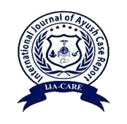Effectiveness of bio-purification therapy of Ayurveda followed by Simhasana in the management of Hypothyroidism
Abstract
Hypothyroidism, an endocrine illness affects more commonly women of all age groups these days and alters their metabolism. Hypothyroidism has turned into a lifestyle disorder as a result of sedentary habits, a diet heavy in fast food, and a bad lifestyle. Swelling all over the body, puffiness on face and eyes, muscle ache, breathlessness, leg cramps, hair fall, dry cold and clammy skin, menstrual abnormality, infertility are some the signs and symptoms of hypothyroidism. Although there is no any such description as hypothyroidism in Ayurveda texts, It can be put as heading clinically with Dhatvagni Mandhya orVaishamya. In this case female patient of 40 year old was pre diagnosed with Hypotrhyroidism for 10 years visited our hospital and manage with the Therapeutic purgation along with oral medication Ajmodadi Churna 3gm twice before the meal with luke-warm water administered followed by Simhasana ( type of yoga) to manage Hypothyrodism. The result was assessed on the basis of clinical symptoms and thyroid function test periodically. From this case can be use the Ayurveda along with Yoga to manage the hypothyroidism.

This work is licensed under a Creative Commons Attribution-NonCommercial-NoDerivatives 4.0 International License.

